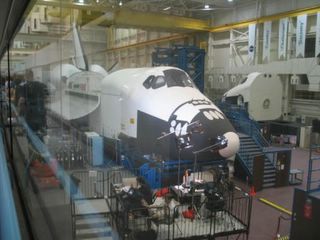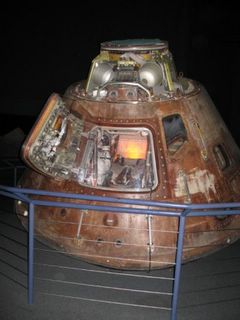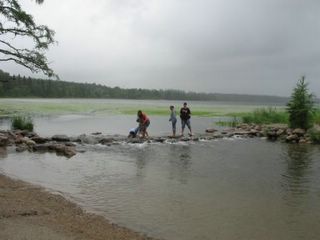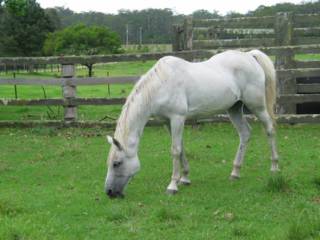After a few days relaxing in our local area, we headed back towards Terni (the birth place of St. Valentine) where we had heard there was a famous waterfall. The Marmore waterfall, the highest in Italy, was very spectacular and worth the trip. But all is not as it seems. The falls are basically man made. The upper Velino River was held back in the marshes of the Rieta Plain and after heavy rain would back up and flood farmland. In 271BC, a canal was built right up to the escarpment in an attempt to alleviate the problem. But this was not a permanent solution. Over the centuries more and more excavation work took place until in 1788, a final cut allowed the Velino to flow over into the lower Nera River to form the falls. A source of hydroelectricity, they are turned on and off on a daily basis according to an annual timetable. There is an excellent surrounding natural park with walking trails that allow you to get many views, top to bottom, of the falls.
It was here we avoided a parking fine by seconds (so who cares if I was in one of the emergency vehicle bays, it was close to the falls). We quickly moved the car from under the nose of a policeman as he was booking other errant cars. All we got was a raised eyebrow. Reading Italian parking signs is almost impossible even if you speak fluent Italian. They are a cross between legal contract speak and cryptic crossword clues.
We traveled up the beautiful Nera Valley with its tiny hill towns and castle ruins to Norcia. This town is famous for its black truffles, cheese, sausages and salami. It is also the birthplace of St. Benedict and his twin sister St. Scholastica. Although continually ravaged by earthquakes, the town is still surrounded by a combination of Roman and 13th century walls which are accessed through their eight gates. The square, Piazza San Benedetto, in the centre of town with its severe statue of the saint has a great feel. We had a delicious lunch here where the waiter willingly helped us with our Italian and gave us a hearty “Viva Australia!!!!”on our departure. (He really seemed pleased we weren’t English!).
Driving on into the unknown, we climbed a steep, narrow and windy road with a mind-numbing drop off up past the tree line into the Mount Sibillini National Park. There was only one comment that could be made as we drove over the last ridge at 1600 meters.
That was “WOW!!!”
In front of us was the flattest of flattest plains, the circular16 sq. km karstic meadow, Piano Grande, with its backdrop of snowy peaks. A hill town, Castelluccio with its 40 inhabitants sits on an upper corner of the plain. The snowfall here must be huge as the town is cut off from the rest of the world in winter. The road markers were at least 4m high. The area is famous for its lentils and there seemed to be plenty of cattle grazing. Apparently the whole area is covered in wild flowers in late spring. Sadly, we were too early!
After absorbing the view for quite a while we drove down across the plain, through the town and then climbed out through the di Gualdo pass and headed back home via Foligno through some of the most spectacular mountain scenery.
This day had to be one of the trip’s highlights. And not a fresco, work of art or church in sight.
We also made the “pilgrimage” to Assisi. This is one of the most popular places to visit in Umbria. As you enter the city through the Porta Nuova after riding up a number of escalators from one of the many lower level car parks, you initially have the feeling you could be in St. Francisland in Disneyworld. But thankfully the history and beauty of the place push the crass commercialism into the background.
Initially populated by the Umbrians, then the Romans, the town took on its current “look” during the 13th and 14th centuries. The town is full of interesting buildings set on narrow steep streets, laneways and around vast piazzas. It too suffered from the 1997 earthquake and restoration works continues. The skyline is interrupted by numerous cranes and streets are blocked by scaffolding.
The Basilica di Santa Chiara is a great looking building both outside (huge supporting buttresses and alternating layers of red and white stone) and inside where the remains of St.Clare are interred. The square of the same name is a hive of activity and a pleasant place to sit, catch your breath, have a coffee and look up into the city.
Another church, the Chiesa Nuova stands on the place where St. Francis’s father, and possibly St. Francis himself, were born.
Then you come across the Piazza del Commune, the heart of Assisi. This square with its ornate central fountain is surrounded by two 13th century palaces, a 1st century Roman temple and a 14th century bell tower. We really liked the Temple of Minerva with its classic Corinthian columns and travertine steps. It became a church, a group of shops, a town hall and now (since 1456) a church again. The interior is quite garish but stunning Baroque.
Heading down the steep Via San Francesco past rows of medieval buildings you finally arrive at what most people come to Assisi for, the Basilica di San Francesco. This church was dedicated to St. Francis by Pope Gregory IX and began construction in 1227 and finished in 1367. What can you say about this building? “Amazing” doesn’t do it justice.
It consists of an upper and lower church. The walls and ceiling of the upper church are covered (and I mean covered!) in frescoes depicting the life of St. Francis as well as episodes from the old and new testaments. No pictures are allowed inside so I suggest you get on the net and find some. Clicking on the link below will give you some idea.
http://www.bellaumbria.net/Assisi/basilica-superiore-san-francesco.jpg
We sat there for an hour and could not absorb it all.
The lower church is in complete contrast, being more somber and gloomy but at the same time just as artistically rich. The tomb of St. Francis lies in the crypt and is obviously a place of true pilgrimage judging from the huge number of religious and lay people meditating and praying here. Despite considerable earthquake damage the church has been restored to its former glory. This was our man made highlight of the trip.
In the lower square of the church there is a toilet. Costs you EU 0.50 ($A1) to get in but it must be the most ornate bog in the world. High vaulted ceilings and polished wall to wall Italian marble with urinals that must have the best view of any toilet in the world. You look out a huge glass window over the expanse of Valle Umbria. No wonder they have a sign in various languages at the door reminding you to zip up. In our public toilet rating system, this scored a 15/10. Now I know why Catholics build on the top of hills.
We found a nice little restaurant in an ancient vaulted building which had highlighted its Roman origins behind glass partitioning and blew the budget on slow cooked lamb and roast vegetables as well as an excellent local red wine. Budget blowing had by now become an art form.
Finally we climbed back up narrow streets to the Umbrian Romanesque Duomo, San Rufino, which was disappointingly closed for the long Italian lunch. This church has significant historical connection with Assisi but is pretty well ignored by the tourists. We sat quietly on the deserted steps, letting our lunch settle and looking at the huge fortress, Rocca Maggiore, which dominates the Assisi skyline. It was here I bought my souvenir of Umbria. In a small shop, on a narrow lane, a lady artist was painting naive hill town landscapes on glass. I hope mine survives the trip home.
That night we met up with a lady who runs a cooking class near Assisi. We and two other couples went to a local gourmet store and learnt all there is to know about Umbrian truffles, olive oil, hams, cheese and wine. We then went back to her house, high in the hills above the town and settled down to do some cooking in a well-appointed kitchen. It was fun meeting up with other visitors and sharing experiences but what we ended up cooking and finally eating that evening was a bit stodgy. We could have had a really nice meal, or maybe two, in Montefalco for the price of the class.
As a result of that late evening, our planned early morning start to Florence was somewhat delayed but we managed to get to Foligno station around 9am and catch a slow train, arriving around midday. The Hotel Porta Faenza we had found on the net was excellent, close to the station and within walking distance of most of the attractions.
After lunch we headed for the Duomo, one of the world’s largest churches, with its huge dome and walls of white, pink and green marble as well as amazing doorways. When you walk inside, the enormity of the place strikes you, as does the height of the dome as you gaze up at the frescoes. Giotto’s Bell Tower and the Baptistery complete the collection of buildings that surround the Piazza del Duomo.
The Piazza della Signoria, a huge square, is dominated by the Palazzo Vecchio outside of which stand some pretty impressive but much maligned statues including the Neptune Fountain and a bad copy of David. It was here that we decided that Florence, beautiful as it was, was not our sort of town. It was incredibly crowded with tour groups, touts and begging gypsies. If on cue to give us another reason not to hang around, it started to rain and eventually the heavens opened up. We scampered for the nearest café, on the way consuming a very large chocolate gelato between us ($12! Why didn’t I read the price list correctly?). We supplemented this sugar hit with a couple of cups of coffee as well as cheesecake and apple cake. With a break in the rain, we headed for the River Arno and the famous Ponte Vecchio which is covered in houses and shops. This is the centre of the Florentine gold jewellery industry. One famous goldsmith, Cellini, is commemorated with a bust in the middle of the bridge. This bust and its surrounds had been covered in thousands of padlocks by lovers who had written their names on them. A city workman was busy cutting them all off. Apparently this is an annual phenomenon.
That night we had a lovely dinner in a small restaurant near the hotel washed down with an expensive bottle of Chianti. Well, after all, we were in Tuscany even if for a short time.
Next morning, we headed directly for the station as it was still raining cats and dogs and caught an even slower train back to Foligno and our quiet sanctuary in the countryside.
The weather cleared the next morning so we made for Dureta, which has been inhabited since Neolithic times and has been involved in the production of ceramics since the middle ages. There are some 200 businesses there now each selling their particular style of pottery. It was all very well made and decorative but typically “fussy” so our Euros stayed in our pockets. It was on the way home I think I got nabbed by a radar speed camera. Nothing has turned up on my credit card as yet. So much for traveling 20km/hr over the speed limit to keep up with the locals.
Orvieto stands high on the top of the remains of an ancient volcano. Being seasoned hill town visitors by now we took the gamble and headed up the hill to find a parking spot in the town. And we did. This place has been occupied since 800BC and has changed little in the last 500 years. We walked around the narrow streets window shopping and taking in the small squares and medieval buildings, eventually ending up at the amazing Gothic Duomo. The building features blue/grey and white horizontally stripped walls and an extremely ornate façade of mosaics and sculptures. The bas-reliefs on the door surrounds tell the story of the Creation to the Last Judgement, and are virtually a Bible in stone. The interior is just as impressive with a similar wall design, huge stain glassed windows, impressive statues and a myriad of frescoes in the main hall as well as in the chapels and the sanctuary. It took 300 years to complete. Just when you think you may be “churched out”, a building like this revives the spirit. We sat and drank coffee in the nice open square watching the passing parade of tour groups, school children and locals as the sun progressed over the cathedral until it highlighted the colored tiles on the façade.
Then we headed for lunch in a modern Italian restaurant this time. Food was excellent but we confirmed our lack of appreciation of Orvieto Classico secco (Trebbiano, Verdello and Chardonnay). One thing I noticed in most places we ate was how fine and tender the pasta was, especially in the lasagna and cannelloni. Not at all like the plastic glug we get at home. Maybe it was all freshly made.
After a final walk around the ramparts of the old Rocco enjoying the view of the Tiber Valley and a decision not to descend (and as a result compulsorily ascend) the 248 steps of the ancient well, Pozzo di San Patrizo, dug seven storeys deep as a water supply during sieges, we headed home through the countryside of lakes, rivers, vineyards and olive groves to enjoy our last evening at “home”.
Up early next morning, we dropped off the Alpha at Terni and arrived at Rome Airport via a couple of train trips. Not all went smoothly. We, and other passengers, were shunted unceremoniously off the airport train at Rome’s Tiburtina station by an irate official. From a rather noisy and demonstrative argument (hand waving, shouting and apparently obscene gestures) between him and a few customers I gathered we were on the wrong train. A policeman had to come and calm things down.
We later established that the television monitors and the departure board at the station did not coincide leading to considerable confusion about train times and departure platforms.
Checking in and passing emigration and security was a breeze at Fiumicino airport so it was “Arrivederci Italia” and “Guten Tag Deutschland”!
































